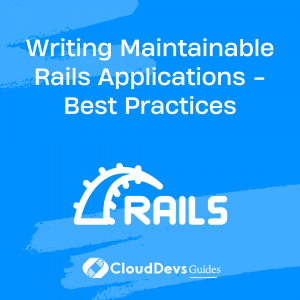Writing Maintainable Rails Applications – Best Practices
Table of Contents
As Rails applications grow in complexity, maintaining them can become increasingly difficult. Code that was once easy to manage can quickly become tangled and difficult to navigate, making it hard to add new features or fix bugs. To avoid this, it’s important to write maintainable code from the beginning.
In this article, we’ll explore some best practices for writing maintainable Rails applications.
1. Follow the Rails conventions
Rails is built around a set of conventions, which make it easy to write maintainable code. When you follow these conventions, it’s easier for other developers to understand your code, and it’s also easier to work with other people’s code. Here are a few examples of Rails conventions:
- File and directory names should follow a specific structure (for example, models should be stored in the “app/models” directory).
- Controllers should be RESTful and follow the seven standard actions (index, show, new, create, edit, update, and destroy).
- Views should be named after the controller actions they correspond to (for example, the view for the “show” action of a “users” controller should be named “show.html.erb”).
2. Write modular code
Modular code is code that is broken down into small, reusable components. By breaking your code down into small, modular pieces, you make it easier to test, debug, and maintain. Here are a few tips for writing modular code:
- Use helper methods to encapsulate common functionality.
- Break your code down into small, well-defined methods.
- Use inheritance and modules to share functionality across your application.
3. Write self-documenting code
Self-documenting code is code that is easy to read and understand without the need for extensive comments. Here are a few tips for writing self-documenting code:
- Use descriptive method and variable names.
- Use consistent naming conventions.
- Write code that reads like English sentences (for example, “if user.is_admin?” is more readable than “if user.admin == true”).
4. Keep controllers skinny
Controllers should be kept as simple and concise as possible. They should be responsible for handling HTTP requests and returning responses, but they should not contain business logic. Here are a few tips for keeping controllers skinny:
- Move business logic into the model layer.
- Use before filters to execute common code before certain actions.
- Use responders to generate responses to requests.
5. Write testable code
Writing testable code is essential for maintaining Rails applications. When your code is testable, it’s easier to catch bugs early, and it’s also easier to make changes to your code without introducing new bugs. Here are a few tips for writing testable code:
- Write tests for every piece of functionality.
- Use mocks and stubs to isolate your code from external dependencies.
- Use factories to generate test data.
6. Use a consistent coding style
Consistency is key when it comes to writing maintainable code. Using a consistent coding style makes it easier for other developers to understand your code, and it also makes it easier to work with other people’s code. Here are a few tips for using a consistent coding style:
- Use a style guide, such as the Ruby Style Guide.
- Use a linter, such as Rubocop, to enforce your style guide.
- Use automated code formatting tools, such as Prettier or Black.
7. Use meaningful comments
While self-documenting code is important, there are still times when you’ll need to use comments to explain your code. When you do use comments, make sure they are meaningful and helpful. Here are a few tips for writing meaningful comments:
- Explain the “why” behind your code, not just the “what”.
- Use comments to explain tricky or complex code.
- Avoid commenting redundant or obvious code.
8. Keep your code DRY
The DRY principle (Don’t Repeat Yourself) is a key aspect of writing maintainable code. When you repeat code, it becomes harder to maintain, as you’ll need to make changes to multiple places if something needs to be updated. Here are a few tips for keeping your code DRY:
- Use helper methods and partials to eliminate duplication in views.
- Use inheritance and modules to share functionality across your application.
- Use concerns to extract common functionality from models.
9. Use version control
Version control is an essential tool for maintaining Rails applications. It allows you to keep track of changes to your code over time, and it also makes it easy to collaborate with other developers. Here are a few tips for using version control:
- Use a version control system, such as Git.
- Use feature branches to work on new features or bug fixes.
- Use pull requests to review and merge code changes.
10. Use third-party libraries judiciously
Third-party libraries can be a powerful tool for building Rails applications quickly, but they can also introduce complexity and make it harder to maintain your code. Here are a few tips for using third-party libraries judiciously:
- Use well-known, actively maintained libraries.
- Don’t use libraries for functionality you can easily build yourself.
- Make sure you understand the library’s code before using it in your application.
11. Conclusion
Writing maintainable Rails applications is essential for the long-term success of your project. By following these best practices, you can ensure that your code is easy to understand, test, and maintain. Remember to keep your code modular, self-documenting, and DRY, and use version control and third-party libraries judiciously. With these practices in place, you can build Rails applications that are easy to maintain and evolve over time.



